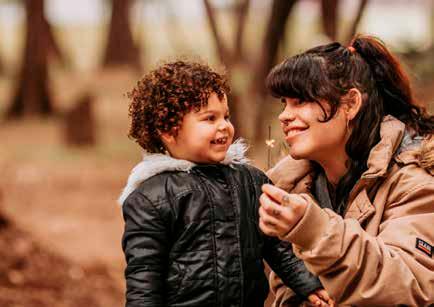
3 minute read
Expressing Love to Your Child with Autism
BY EMILY CRANE, HEALING HAVEN
Our culture has preconceived ideas of what love looks like. Since autism can cause differences in communication, understanding of context, and atypical sensory perceptions, some may believe a person with autism won’t understand love. However, developing relationships and learning to express and receive love when you have autism is not only possible but important.
With February being the month of “love”, this is a great time to share ideas to help build these relationship skills. We can model acts of love for individuals with autism by understanding what makes them feel loved.

Using Love Languages to Express Love
Our founder and president, Jamie McGillivary, MS, LLP, BCBA, LBA, uses Dr. Gary Chapman’s book The 5 Love Languages as her resource on this subject We all have a “love language”, so it’s important to identify which “language” your child or loved one with autism uses to love. Here we include examples for each love language:
Receiving Gifts
Gifting a child with autism an item they are interested in, such as a sensory toy, Legos, new fidgets or a book with their favorite character may be what fills their cup. But you can also think outside the box and consider experiences. Look for sensory-friendly events and activities in your area that might appeal to your child.

Quality Time
If your child’s love language is quality time, it may be challenging to identify it. So, use their behavior to guide you. Are they constantly in your space, repeating your name, or otherwise doing something to get your attention? If this sounds like your child, set aside dedicated time to honor their requests and engage with an activity they want to do. Remember to not place demands on them during quality time.
Physical Touch
Children with autism seek sensory input in a multitude of ways. Some may like hugs and cuddles, while others may only accept a hug from the side or back. Some children only seek sensory input in broader ways through their environment. If this is your child, consider taking them outside for the sensation of the cold and snow. Or create a sensory bin with tactile objects and play next to them.

Words of Affirmation
Many children with autism are visual learners. As a result, they may respond better to pictures, videos, and written words over spoken words of affirmation. To connect with your child in this way, consider making a photo book of experiences from a trip or outing, or pictures of friends and family that they will enjoy looking at.
Acts of Service
Caring for a child with autism requires additional “acts of service” to meet their unique needs every day. So, another way to recognize this love language is to schedule your own self-care time - like a massage or dedicated time to do what you love. Doing so will help your stress levels, so you can continue to serve your child with love.
We hope you’ve learned some new ways to express love and connect to your child with autism. For more indepth information, get a copy of The 5 Love Languages – there is also a children’s version!
To learn more about the comprehensive autism services at Healing Haven, visit thehealinghaven.net.








